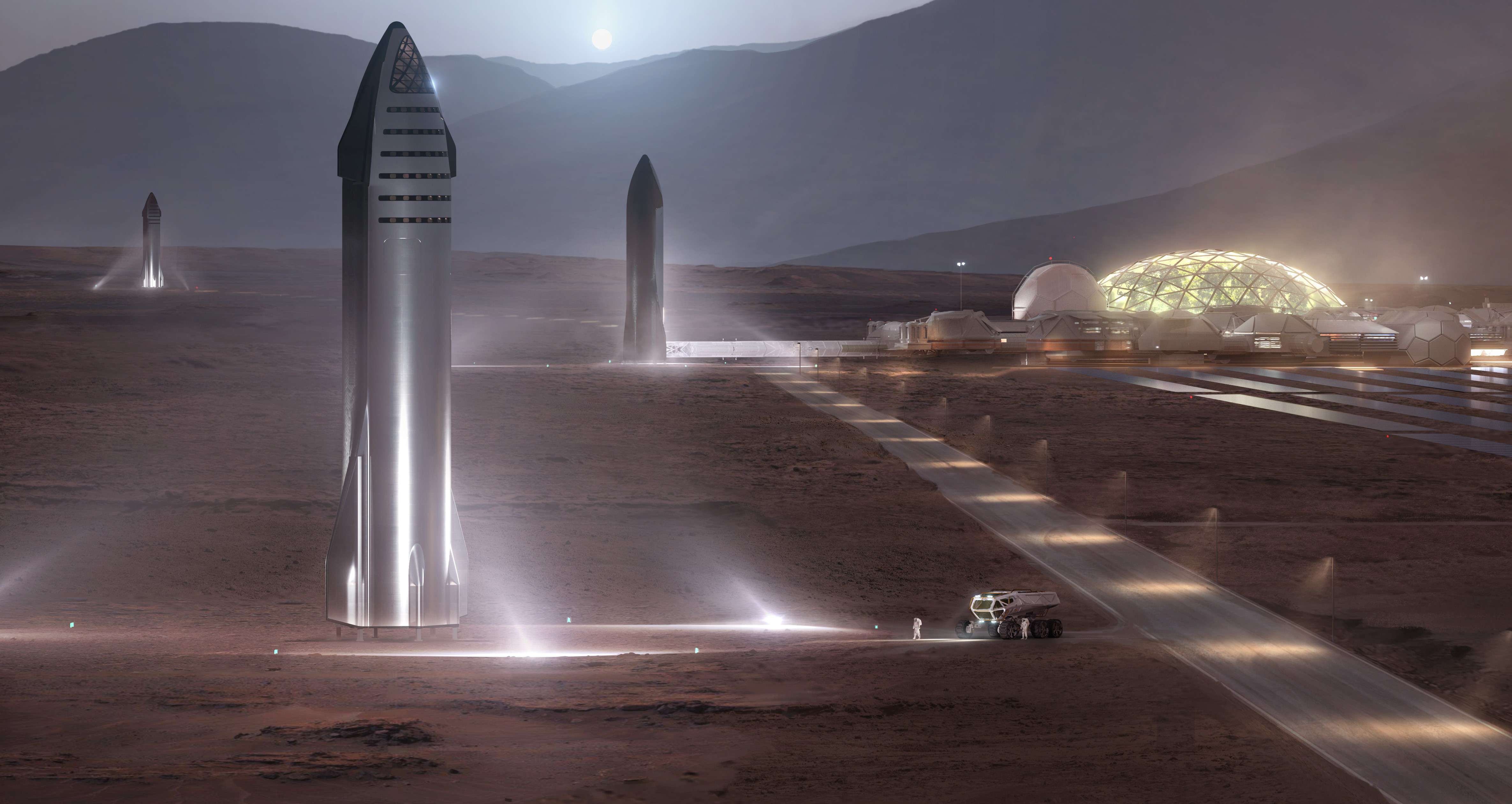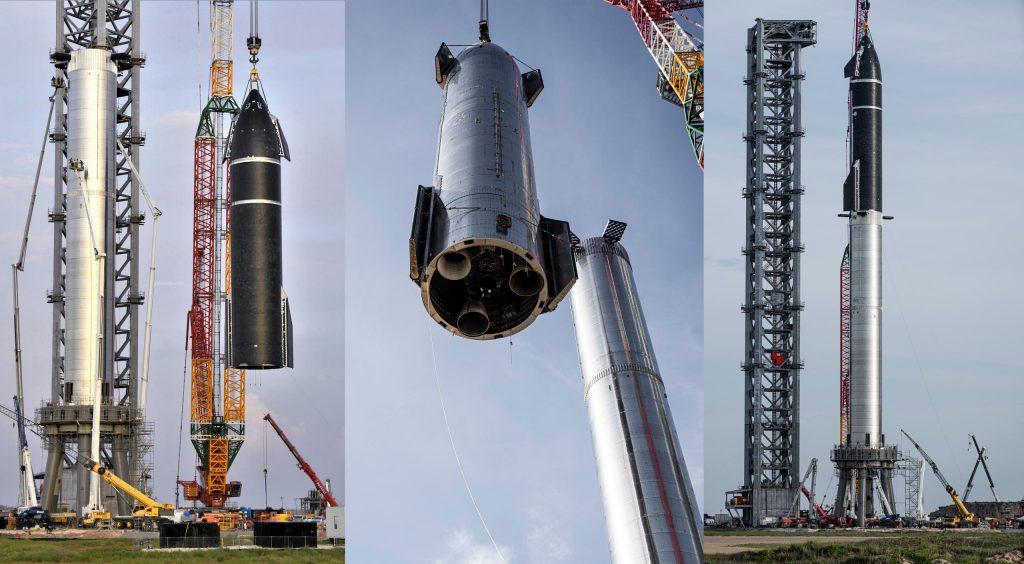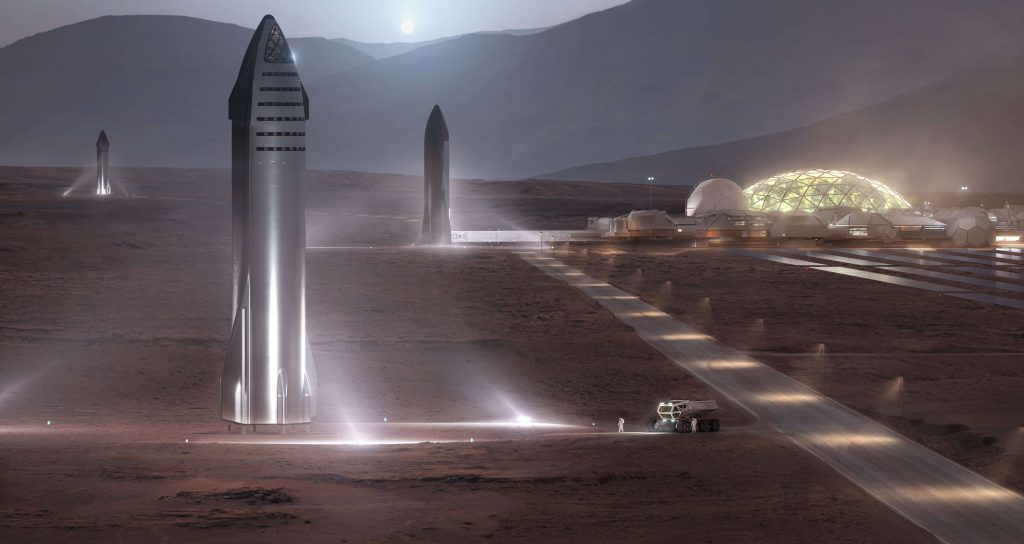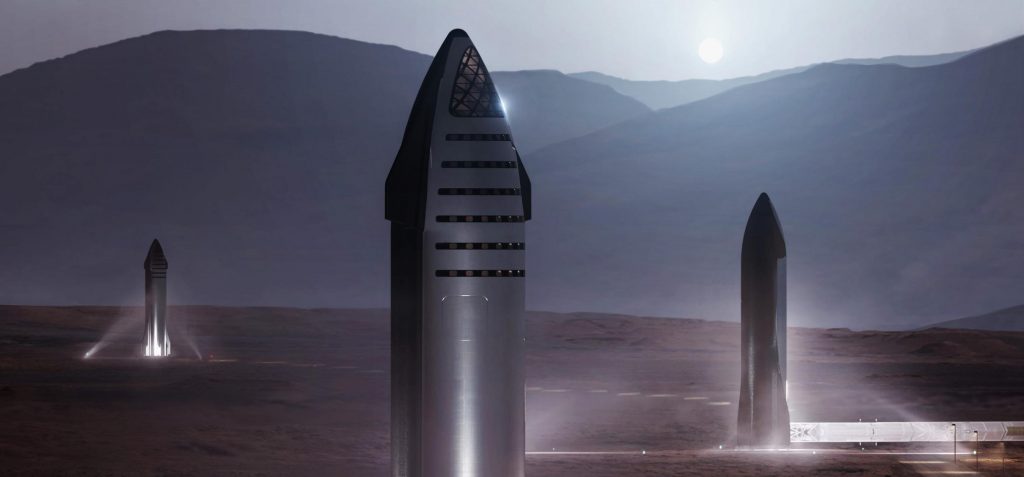

News
SpaceX details plan to build Mars Base Alpha with reusable Starship rockets
For the first time, SpaceX has teamed up with researchers from NASA and several other US institutions to publicly discuss how it plans to use Starship to build Mars Base Alpha.
Save for a handful of comments spread around the periphery of SpaceX and CEO Elon Musk’s main focus, Starship itself, the company and its executives have almost never specifically discussed how the next-generation fully-reusable rocket will be used to create a permanent human presence on Mars. For the most part, that clear focus on near-term hurdles is hard to fault. Half a century of mostly theoretical analysis has made it abundantly clear that a permanent and sustainable extraterrestrial human outpost is impossible without a radical reduction in the cost of access to space. For decades, NASA has studied and studied and studied slight variations of a plan that would cost hundreds of billions of dollars to send a few astronauts to Mars for a few months at a time.
Put simply, without a revolution in space transport, even a temporary presence on Mars where inhabitants are mostly dependent on imported goods is infeasible unless Mars exploration is made a national or international priority on the order of tens of billions of dollars per year. Over the 80-90 years that spaceflight has been seriously pondered, dozens of groups and papers and studies and space agencies have imagined what that revolution might look like and SpaceX is not unique for proposing a solution to that longstanding problem. However, SpaceX is the first of that long list of contenders to propose a solution and both invest significant resources and put hammer to metal in an attempt to make that vision real.

Two years after SpaceX announced its intention to build that next-generation space transportation system, Musk revealed a radical design change and work on the first steel Starship prototypes began. Three years later, SpaceX has completed nine Starship test flights – four brief hops and five flights above 10 km (6 mi). In 2021 alone, SpaceX completed four of those high-altitude flight tests, recovered a high-altitude prototype intact for the first time, built the first orbital-class ship and booster prototypes, began testing that ship, and is nearly finished the first orbital Starship launch site from scratch. In April, SpaceX also secured a $2.9 billion NASA contract to build a human-rated Moon lander variant of Starship.
Put simply, SpaceX – and now NASA with it – has laid a sturdy foundation upon which Starship will almost certainly be realized. A great deal of work remains but SpaceX has more or less surmounted most of the major technical hurdles that towered over Starship/BFR/ITS just a few years ago. A wealth of Starship ground and flight tests have firmly demonstrated that the rocket’s structures, avionics, Raptor engines, exotic methods of descent and landing, and previously unflown fuel of choice are all ready for orbital flight. From then on, SpaceX will still need to prove out Starship’s massive, ceramic, non-ablative heat shield technology; mature orbital rocket refueling techniques and technologies; and finally operationalize all the above to make the rapid launch, reuse, and refueling of the largest rocket in history routine and mundane – something SpaceX has proven to be more than capable of with Dragon and Falcon.
How, then, will SpaceX proceed to the Red Planet?

Packing for Mars
With the help of coauthors from NASA Ames, SETI, and half a dozen prestigious US universities and institutes, SpaceX has begun to answer exactly that question in a 2021 whitepaper [PDF] submitted for the National Academies’ next Planetary Science and Astrobiology Decadal Survey. While that survey alone could influence NASA as the agency prepares to outline its next decade of space science and determine the ultimate destination of tens of billions of federal dollars, the consequences of which could be immense, SpaceX also used the paper to describe its plans for early missions to Mars in unprecedented detail.
As has always been the plan, SpaceX will begin the process of constructing sustainable cities on Mars with a few (relatively) simple steps. Likely as soon as the mid-2020s, SpaceX will begin launching uncrewed Starships to Mars to both verify the system’s maturity and readiness and “deliver significant quantities of cargo to the surface in advance of human arrival.” Likely leaning on a wide range of robotics, those early missions will help SpaceX characterize local resources, stage supplies, test technologies for long-duration Martian surface ops, and begin developing infrastructure – with a propellant plant likely the most pressing need. None of that is surprising. However, there’s more.

According to the authors, which include several current and former SpaceX engineers, “current SpaceX mission planning [tasks those early uncrewed Starships with delivering] equipment for increased power production, water extraction, LOX/methane production, pre-prepared landing pads, radiation shielding, dust control equipment, exterior shelters for humans and equipment, [and more – all hardware needed to support the first human base.]”
Further, confirming what’s been assumed to be the plan for years, “humans will likely live on [Starships] for the first few years until additional habitats are constructed” and “the first wave of uncrewed Starships can also be relocated and/or repurposed as needed to support the humans on the surface,” serving as “valuable assets for storage, habitation, [scientific laboratories], and a source of refined metal structures and resources.” The paper also states that “SpaceX is aggressively developing Starship to…conduct initial test flights to Mars…as soon as 2022 [or 2024]” and even raises the possibility of SpaceX launching the first Starship(s) to Mars before the rocket’s first lunar mission but then launching a separate lunar mission and landing a different Starship on the Moon while the Marsbound ship or ships are still in transit.

The whitepaper marks the first time that SpaceX (or those familiar with the company’s plans) has properly fleshed out the basics of its first crewed and uncrewed Starship missions to Mars and confirms a great deal of well-informed speculation. Namely, SpaceX appears to intend to pack even the very first Mars-bound ships with supplies. But even if they don’t bring much, the first Martian immigrants – launched in batches of “10-20 people” alongside “100+ metric tons” (~220,000+ lb) of cargo – will reuse all surviving Starships as pre-emplaced habitats, storage tanks, and raw material feedstock. Early cargo will focus on power, water, and propellant production, as well as shelters, radiation shielding, and the construction of prepared landing pads. Unsurprisngly, early residents will likely make the Starships that carry them to Mars their first homes on the surface of the Red Planet, taking advantage of an ~1100m³ (~39,000ft³) pressurized volume already outfitted to keep dozens of people alive and healthy in deep space for months at a time.
Elon Musk
Tesla reveals it is using AI to make factories more sustainable: here’s how
Tesla is using AI in its Gigafactory Nevada factory to improve HVAC efficiency.

Tesla has revealed in its Extended Impact Report for 2024 that it is using Artificial Intelligence (AI) to enable its factories to be more sustainable. One example it used was its achievement of managing “the majority of the HVAC infrastructure at Gigafactory Nevada is now AI-controlled” last year.
In a commitment to becoming more efficient and making its production as eco-friendly as possible, Tesla has been working for years to find solutions to reduce energy consumption in its factories.
For example, in 2023, Tesla implemented optimization controls in the plastics and paint shops located at Gigafactory Texas, which increased the efficiency of natural gas consumption. Tesla plans to phase out natural gas use across its factories eventually, but for now, it prioritizes work to reduce emissions from that energy source specifically.
It also uses Hygrometric Control Logic for Air Handling Units at Giafactory Berlin, resulting in 17,000 MWh in energy savings each year. At Gigafactory Nevada, Tesla saves 9.5 GWh of energy through the use of N-Methylpyrrolidone refineries when extracting critical raw material.
Perhaps the most interesting way Tesla is conserving energy is through the use of AI at Gigafactory Nevada, as it describes its use of AI to reduce energy demand:
“In 2023, AI Control for HVAC was expanded from Nevada and Texas to now include our Berlin-Brandenburg and Fremont factories. AI Control policy enables HVAC systems within each factory to work together to process sensor data, model factory dynamics, and apply control actions that safely minimize the energy required to support production. In 2024, this system achieved two milestones: the majority of HVAC infrastructure at Gigafactory Nevada is now AI-controlled, reducing fan and thermal energy demand; and the AI algorithm was extended to manage entire chiller plants, creating a closed-loop control system that optimizes both chilled water consumption and the energy required for its generation, all while maintaining factory conditions.”
Tesla utilizes AI Control “primarily on systems that heat or cool critical factory production spaces and equipment.” AI Control communicates with the preexisting standard control logic of each system, and any issues can be resolved by quickly reverting back to standard control. There were none in 2024.
Tesla says that it is utilizing AI to drive impact at its factories, and it has proven to be a valuable tool in reducing energy consumption at one of its facilities.
Elon Musk
Tesla analysts believe Musk and Trump feud will pass
Tesla CEO Elon Musk and U.S. President Donald Trump’s feud shall pass, several bulls say.

Tesla analysts are breaking down the current feud between CEO Elon Musk and U.S. President Donald Trump, as the two continue to disagree on the “Big Beautiful Bill” and its impact on the country’s national debt.
Musk, who headed the Department of Government Efficiency (DOGE) under the Trump Administration, left his post in May. Soon thereafter, he and President Trump entered a very public and verbal disagreement, where things turned sour. They reconciled to an extent, and things seemed to be in the past.
However, the second disagreement between the two started on Monday, as Musk continued to push back on the “Big Beautiful Bill” that the Trump administration is attempting to sign into law. It would, by Musk’s estimation, increase spending and reverse the work DOGE did to trim the deficit.
Every member of Congress who campaigned on reducing government spending and then immediately voted for the biggest debt increase in history should hang their head in shame!
And they will lose their primary next year if it is the last thing I do on this Earth.
— Elon Musk (@elonmusk) June 30, 2025
President Trump has hinted that DOGE could be “the monster” that “eats Elon,” threatening to end the subsidies that SpaceX and Tesla receive. Musk has not been opposed to ending government subsidies for companies, including his own, as long as they are all abolished.
How Tesla could benefit from the ‘Big Beautiful Bill’ that axes EV subsidies
Despite this contentious back-and-forth between the two, analysts are sharing their opinions now, and a few of the more bullish Tesla observers are convinced that this feud will pass, Trump and Musk will resolve their differences as they have before, and things will return to normal.
ARK Invest’s Cathie Wood said this morning that the feud between Musk and Trump is another example of “this too shall pass:”
BREAKING: CATHIE WOOD SAYS — ELON AND TRUMP FEUD “WILL PASS” 👀 $TSLA
She remains bullish ! pic.twitter.com/w5rW2gfCkx
— TheSonOfWalkley (@TheSonOfWalkley) July 1, 2025
Additionally, Wedbush’s Dan Ives, in a note to investors this morning, said that the situation “will settle:”
“We believe this situation will settle and at the end of the day Musk needs Trump and Trump needs Musk given the AI Arms Race going on between the US and China. The jabs between Musk and Trump will continue as the Budget rolls through Congress but Tesla investors want Musk to focus on driving Tesla and stop this political angle…which has turned into a life of its own in a roller coaster ride since the November elections.”
Tesla shares are down about 5 percent at 3:10 p.m. on the East Coast.
Elon Musk
Tesla scrambles after Musk sidekick exit, CEO takes over sales
Tesla CEO Elon Musk is reportedly overseeing sales in North America and Europe, Bloomberg reports.

Tesla scrambled its executives around following the exit of CEO Elon Musk’s sidekick last week, Omead Afshar. Afshar was relieved of his duties as Head of Sales for both North America and Europe.
Bloomberg is reporting that Musk is now overseeing both regions for sales, according to sources familiar with the matter. Afshar left the company last week, likely due to slow sales in both markets, ending a seven-year term with the electric automaker.
Tesla’s Omead Afshar, known as Elon Musk’s right-hand man, leaves company: reports
Afshar was promoted to the role late last year as Musk was becoming more involved in the road to the White House with President Donald Trump.
Afshar, whose LinkedIn account stated he was working within the “Office of the CEO,” was known as Musk’s right-hand man for years.
Additionally, Tom Zhu, currently the Senior Vice President of Automotive at Tesla, will oversee sales in Asia, according to the report.
It is a scramble by Tesla to get the company’s proven executives over the pain points the automaker has found halfway through the year. Sales are looking to be close to the 1.8 million vehicles the company delivered in both of the past two years.
Tesla is pivoting to pay more attention to the struggling automotive sales that it has felt over the past six months. Although it is still performing well and is the best-selling EV maker by a long way, it is struggling to find growth despite redesigning its vehicles and launching new tech and improvements within them.
The company is also looking to focus more on its deployment of autonomous tech, especially as it recently launched its Robotaxi platform in Austin just over a week ago.
However, while this is the long-term catalyst for Tesla, sales still need some work, and it appears the company’s strategy is to put its biggest guns on its biggest problems.
-

 Elon Musk1 day ago
Elon Musk1 day agoTesla investors will be shocked by Jim Cramer’s latest assessment
-

 News6 days ago
News6 days agoTesla Robotaxi’s biggest challenge seems to be this one thing
-

 News2 weeks ago
News2 weeks agoTesla’s Grok integration will be more realistic with this cool feature
-

 Elon Musk2 weeks ago
Elon Musk2 weeks agoElon Musk slams Bloomberg’s shocking xAI cash burn claims
-

 News2 weeks ago
News2 weeks agoTesla China roars back with highest vehicle registrations this Q2 so far
-

 News2 weeks ago
News2 weeks agoTexas lawmakers urge Tesla to delay Austin robotaxi launch to September
-

 News2 weeks ago
News2 weeks agoTesla dominates Cars.com’s Made in America Index with clean sweep
-

 Elon Musk1 week ago
Elon Musk1 week agoFirst Look at Tesla’s Robotaxi App: features, design, and more




















